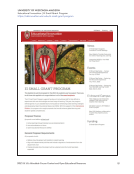30 Survey Results: Survey Questions and Responses
Number of faculty replacing course materials with ACC 3 18%
Number of faculty adapting OER 3 18%
Number of faculty creating OER 3 18%
Number of faculty supplementing course materials with ACC 2 12%
Number of faculty creating ACC 2 12%
Number of faculty supplementing course materials with OER 2 12%
Increase in course completion 1 6%
Increase in student retention 0 —
Reduction in student drops 0 —
Other metric 11 65%
Please briefly describe the other metric. N=11
I have had faculty evaluate their projects by examining grade patterns and comparing prior years and
the semester they used an alternate textbook. The primary assessment method is for faculty to survey
students about their experience with an alternate textbook and then share that in a final report so it is a
mix of quantitative and qualitative findings.
Number of students whose decision to apply to School of Public Health was influenced by
OER programs.
Perception of students using OpenStax College Physics textbook
Proportion of materials already held in licensed collection vs. held in print.
Qualitative
Student satisfaction with use of OER in classes
Surveys of students and instructors
Types of resources created and university services utilized.
Use of video lectures and self-evaluation of learning effectiveness
We are tracking the faculty who have reviewed Open Educational Materials and if they have adopted.
We will track to see how the outcome goes.
We track the number of faculty awards, but because each award often involves a combination of library-
licensed, -owned, or -digitized materials, OERs, and items the students still have to purchase, it’s
impossible to break that number down into the categories on this list. We also assess whether awardees’
instructional objectives were achieved and the level of satisfaction with the course materials of both
awardees and students.
21. If yes, who is conducting these assessments? Check all that apply. N=22
Conducts Assessment Yes Plan to %
Library 9 3 55%
Teaching and learning group 1 2 14%
Instructional design group 1 2 14%
Academic computing 1 2 14%
High-level administration (president, provost, vice provost, etc.) 2 0 9%
College/academic department/unit 1 0 5%
Number of faculty replacing course materials with ACC 3 18%
Number of faculty adapting OER 3 18%
Number of faculty creating OER 3 18%
Number of faculty supplementing course materials with ACC 2 12%
Number of faculty creating ACC 2 12%
Number of faculty supplementing course materials with OER 2 12%
Increase in course completion 1 6%
Increase in student retention 0 —
Reduction in student drops 0 —
Other metric 11 65%
Please briefly describe the other metric. N=11
I have had faculty evaluate their projects by examining grade patterns and comparing prior years and
the semester they used an alternate textbook. The primary assessment method is for faculty to survey
students about their experience with an alternate textbook and then share that in a final report so it is a
mix of quantitative and qualitative findings.
Number of students whose decision to apply to School of Public Health was influenced by
OER programs.
Perception of students using OpenStax College Physics textbook
Proportion of materials already held in licensed collection vs. held in print.
Qualitative
Student satisfaction with use of OER in classes
Surveys of students and instructors
Types of resources created and university services utilized.
Use of video lectures and self-evaluation of learning effectiveness
We are tracking the faculty who have reviewed Open Educational Materials and if they have adopted.
We will track to see how the outcome goes.
We track the number of faculty awards, but because each award often involves a combination of library-
licensed, -owned, or -digitized materials, OERs, and items the students still have to purchase, it’s
impossible to break that number down into the categories on this list. We also assess whether awardees’
instructional objectives were achieved and the level of satisfaction with the course materials of both
awardees and students.
21. If yes, who is conducting these assessments? Check all that apply. N=22
Conducts Assessment Yes Plan to %
Library 9 3 55%
Teaching and learning group 1 2 14%
Instructional design group 1 2 14%
Academic computing 1 2 14%
High-level administration (president, provost, vice provost, etc.) 2 0 9%
College/academic department/unit 1 0 5%


























































































































































